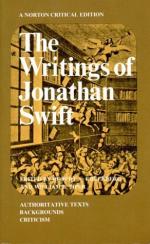[Having already spoken of many abuses relating to signposts, I cannot here omit one more, because it plainly relates to politics; and is, perhaps, of more dangerous consequence than any of the city cries, because it directly tends to destroy the succession. It is the sign of his present Majesty King George the Second, to be met with in many streets; and yet I happen to be not only the first, but the only, discoverer of this audacious instance of Jacobitism. And I am confident, that, if the justices of the peace would please to make a strict inspection, they might find, in all such houses, before which those signs are hung up in the manner I have observed, that the landlords were malignant Papists, or, which is worse, notorious Jacobites. Whoever views those signs, may read, over his Majesty’s head, the following letters and ciphers, G. R. II., which plainly signifies George, King the Second, and not King George the Second, or George the Second, King; but laying the point after the letter G, by which the owner of the house manifestly shews, that he renounces his allegiance to King George the Second, and allows him to be only the second king, inuendo, that the Pretender is the first king; and looking upon King George to be only a kind of second king, or viceroy, till the Pretender shall come over and seize the kingdom. I appeal to all mankind, whether this be a strained or forced interpretation of the inscription, as it now stands in almost every street; whether any decipherer would make the least doubt or hesitation to explain it as I have done; whether any other Protestant country would endure so public an instance of treason in the capital city from such vulgar conspirators; and, lastly, whether Papists and Jacobites of great fortunes and quality may not probably stand behind the curtain in this dangerous, open, and avowed design against the government. But I have performed my duty; and leave the reforming of these abuses to the wisdom, the vigilance, the loyalty, and activity of my superiors.][179]
A SERIOUS AND USEFUL SCHEME
TO MAKE AN
HOSPITAL FOR INCURABLES.
NOTE.
This piece, included by Sir Walter Scott for the first time among Swift’s writings, was, in the opinion of that editor, indisputably the work of the Dean of St. Patrick’s. The present editor sees no reason to disagree with this judgement, and it is therefore reprinted here. The original issue of 1733, printed by Faulkner contained also Swift’s “Petition of the Footmen in and about Dublin,” and had a lengthy advertisement of the Complete Works of Swift which Faulkner was, at that time, projecting. It is difficult, however, to understand why the tract was not included in later editions of Swift’s complete works. Sir Walter Scott puts forward an explanation suggested by Dr. Barrett, who believed the reason to have been, that this “jeu d’esprit might be interpreted as casting




